Toward Knowledge-Based Economy: Innovation and Transformational Leadership in Public Universities in Texas and Qatar
Abstract
1. Introduction
2. Theoretical Background
2.1. Transformational Leadership Traits
2.2. Innovation Classification
2.3. Open Innovation
2.4. Role of Government, Industry, and Academia in KBE Transformation
2.5. Higher Education, Sustainable Development, and Engineering
2.6. Engineering Education for Sustainable Development
2.7. Oil-Dependant States
2.7.1. The Case of Texas
2.7.2. The Case of Qatar
2.8. The United States and Qatar in the Global Innovation Index (GII)
2.9. Hofstede’s Cultural Dimension Framework
3. Methodology
3.1. Research Instruments
3.2. Research Procedure
3.3. Sample
4. Results
4.1. Demographics
4.2. MLQ Descriptive Statistic
4.3. System
4.4. Followership
4.5. Correlation between Leadership, System, and Followership
4.6. Innovative Output Indicators
5. Discussion
“The main players in the innovation process are the top administration body. They do the encouragement and pay the money, which is the reason why it is important to have a leader with administrative experience; they do better in management. We need the right culture to support this.”“It is a top-down process. The vision should be from the top, meaning the dean. However, department heads are very powerful in the implementation process and communicate it and stress it to their faculty. ““It is certainly a top-down process; however, a leader needs a supporting powerful team with highly innovative individuals and early adaptors.”
“An ecosystem needs to be emphasized by the government. For example, they should replace outside consultancy with consultants from the university itself.”
“What the leaders take care of and pay attention to flourish faster, especially when tied to the award system and budget management.”“We need their support in providing more funding for research. It is very stressful because of the high competition.”
“Reducing the gap between faculty and leadership is needed because it minimizes the connection between both, limits the feedback delivered to leadership (from faculty), and limits the direct connection with leadership to describe what is needed exactly from faculty.”“We need better connection. Sometimes changes happen and we don’t know about them in the right time.”“Leaders need to set clear objectives and facilitate large-scale projects, forming teams and putting together mechanisms for funding (which are currently very good), but more is needed.”“Reduced workload in things doesn’t affect innovation or teaching as we have a big amount of reporting.”
“Projects and applied research need better acknowledgement and special reward as they are undervalued.”“I would like leaders to consider having long-term institutional memory for faculty to be eligible for professorship and give more endowment. We have a similar thing, but we need more of it because it helps faculty and encourages them to do more.”
“The government has a good system to define goals, select strong proposals, and follow up. Follow-up is extremely important.”“The proposal review process is very detail-oriented. They check it carefully for achievable tasks and check the faculty’s previous work as part of this review process prior to the selection. It is a transparent fair process here. They care about how to manage the money effectively.”“Government has the responsibility to cultivate a culture for innovation since they drive the funding.”
“We don’t want leadership to be an obstacle. Don’t delay me, but rather help me. A supporting factor here is the fact that it is a flat structure. We have a good autonomy level that helps us be more creative.”“Our leadership gives the right autonomy level to faculty.”
6. Conclusions
Author Contributions
Funding
Acknowledgments
Conflicts of Interest
References
- Abdulwahed, M.; Hasna, M.O. Engineering and Technology Talent for Innovation and Knowledge-Based Economies; Springer: Cham, Switzerland, 2014. [Google Scholar] [CrossRef]
- Khorsheed, M.S. Learning from Global Pacesetters to Build the Country Innovation Ecosystem. J. Knowl. Econ. 2016, 8, 177–196. [Google Scholar] [CrossRef]
- Chesbrough, H. The era of open innovation. MIT Sloan Manag. Rev. 2003, 44, 35–41. [Google Scholar]
- Felgueiras, M.C.; Rocha, J.; Caetano, N. Engineering Education Towards sustainability. In Proceedings of the 4th International Conference on Energy and Environment Research (ICEER 2017), Porto, Portugal, 17–20 July 2017. [Google Scholar]
- WFEO. WFEO MoU. 2014. Available online: http://www.wfeo.org/wfeo-iea-mou/ (accessed on 15 November 2015).
- Al-Mansoori, R.S.; Koc, M. Transformational Leadership, System, and Intrinsic Motivation in Higher Education Institutes: Faculty Perspectives in Engineering Colleges. Sustainability 2019, 11, 4072. [Google Scholar] [CrossRef]
- Muenjohn, N.; Armstrong, A. Transformational Leadership: The influence of culture on the leadership behaviours of expatriate managers. Int. J. Bus. Inf. 2007, 2, 265–283. [Google Scholar]
- Den Hartog, D.N.; Van Muijen, J.J.; Koopman, P.L. Transactional versus transformational leadership: An analysis of the MLQ. J. Occup. Organ. Psychol. 1997, 70, 19–34. [Google Scholar] [CrossRef]
- Felfe, J.; Goihl, K. Transformational Leadership and Commitment. Organ. Dev. Leadersh. 2002, 11, 87–124. [Google Scholar]
- Aryee, S.; Walumbwa, F.O.; Seidu, E.Y.M.; Otaye, L.E. Impact of high performance work systems on individual- and brand-level performance: Test of a multilevel model of intermediate linkages. J. Appl. Psychol. 2012, 97, 667. [Google Scholar] [CrossRef]
- Dorenbosch, L.; van Engen, M.; Verhagen, M. On-the-job innovation: The impact of job design and human resource management through production ownership. Creat. Innov. Manag. 2005, 14, 129–141. [Google Scholar] [CrossRef]
- House, R.J.; Howell, J.M. Personality and Charismatic Leadership. Leadersh. Q. 1992, 3, 81–108. [Google Scholar] [CrossRef]
- Bass, B. Does the transactional–transformational leadership paradigm transcend organizational and national boundaries? Am. Psychol. 1997, 52, 130–139. [Google Scholar] [CrossRef]
- Northouse, P.G. Leadership Theory and Practice, 6th ed.; Sage: Thousand Oaks, CA, USA, 2012. [Google Scholar]
- Price, R.M. Infusing Innovation into Corporate Culture. Organ. Dyn. 2007, 36, 320–328. [Google Scholar] [CrossRef]
- Zyl, H.; Preez, N.; Schutte, C. Utilizing formal innovation models to support and guide industry innovation projects. S. Afr. J. Ind. Eng. 2007, 18, 203–219. [Google Scholar]
- Uppenberg, K. Innovation and Economic Growth; EIB Papers 1/2009; European Investment Bank, Economic and Financial Studies: Kirchberg, Luxemberg, 2009. [Google Scholar]
- Freeman, C. Continental, national and sub-national innovation systems—Complementarity and economic growth. Res. Policy 2002, 31, 191–211. [Google Scholar] [CrossRef]
- Perri, G. Innovation by nonprofit organizations: Policy and research issues. Nonprofit Manag. Leadersh. 1993, 3, 397–414. [Google Scholar] [CrossRef]
- Elster, J. Explaining Technical Change; Cambridge University Press: Cambridge, UK, 1983. [Google Scholar]
- Davies, S. Concentration. In Economics of Industrial Organisation; Davies, S., Lyons, B., Dixon, H., Geroski, P., Eds.; Longman, Harlow: London, UK, 1991. [Google Scholar]
- Gomulka, S. The Theory of Technology Change and Economic Growth; Routledge: London, UK, 1990. [Google Scholar]
- Kamien, M.I.; Schwartz, N.L. Market Structure and Innovation; Cambridge University Press: Cambridge, UK, 1982. [Google Scholar]
- OECD. The Measurement of Scientific and Technological Activities—Proposed Guidelines for Collecting and Interpreting Technological Innovation Data; Oslo Manual; OECD: Paris, France, 2005. [Google Scholar]
- Williamson, O.E. Antitrust Enforcement and the Modern Corporation. In Policy Issues and Essays on Research Opportunities in Industrial Organization; Fuchs, V.R., Ed.; National Bureau of Economic Research: New York, NY, USA, 1972. [Google Scholar]
- Sáenz, J.; Aramburu, N.; Rivera, O. Knowledge sharing and innovation performance—A comparison between high-tech and low-tech companies. J. Intellect. Cap. 2009, 10, 22–36. [Google Scholar] [CrossRef]
- Damanpour, F.; Walker, R.M.; Avellaneda, C.N. Combinative Effects of Innovation Types and Organizational Performance: A Longitudinal Study of Service Organizations. J. Manag. Stud. 2009, 46, 650–675. [Google Scholar] [CrossRef]
- Al-Husseini, S.; Elbeltagi, I. Transformational leadership and innovation: A comparison study between Iraq’s public and private higher education. Stud. High. Educ. 2016, 41, 159–181. [Google Scholar] [CrossRef]
- Jaskyte, K. Transformational Leadership, Organizational Culture and Innovation in Nonprofit Organizations. Nonprofit Organization and Leadership 2004, 15, 153–168. [Google Scholar] [CrossRef]
- Obendhain, A.; Johnson, W. Product and Process Innovation in Service Organizations: The Influence of Organizational Culture in Higher Education Institutions. J. Appl. Manag. Entrep. 2004, 9, 91–113. [Google Scholar]
- Anderson, N.; Potočnik, K.; Zhou, J. Innovation and Creativity in Organizations: A State-of-the-Science Review, Prospective Commentary, and Guiding Framework. J. Manag. 2014, 4, 1297–1333. [Google Scholar] [CrossRef]
- Chesbrough, H. Open Innovation: The New Imperative for Creating and Profiting from Technology; Harvard Business School Press: Harvard, MA, USA, 2003. [Google Scholar]
- Leydesdorff, L.; Ivanova, I. “Open innovation” and “triple helix” models of innovation: Can synergy in innovation systems be measured? J. Open Innov. Technol. Mark. Complex. 2016, 2, 11. [Google Scholar] [CrossRef]
- Chesbrough, H.W. Open Business Models: How to Thrive in the New Innovation Landscape; Harvard Business School Publishing: Cambridge, MA, USA, 2006. [Google Scholar]
- Howells, R.L.; Ramlogan, R.; Cheng, S.L. Universities in an open innovation system: A UK perspective. Int. J. Entrep. Behav. Res. 2012, 18, 440–456. [Google Scholar] [CrossRef]
- Hanel, P.; St-Pierre, M. Industry–university collaboration by Canadian manufacturing firms. J. Technol. Transf. 2006, 31, 485–499. [Google Scholar] [CrossRef]
- Krishna, V.V. Universities in the National Innovation Systems: Emerging Innovation Landscapes in Asia-Pacific. J. Open Innov. Technol. Mark. Complex. 2019, 5, 43. [Google Scholar] [CrossRef]
- Gassmann, O.; Enkel, E.; Chesbrough, H. The future of open innovation. R D Manag. 2010, 40, 213–221. [Google Scholar] [CrossRef]
- Perkmann, M.; Walsh, K. University-industry relationships and open innovation: Towards a research agenda. Int. J. Manag. Rev. 2007, 9, 259–280. [Google Scholar] [CrossRef]
- Carneiro, A. When leadership means more innovation and development. Bus. Stragy Ser. 2008, 9, 176–184. [Google Scholar] [CrossRef]
- Samad, S. The Influence of Innovation and Transformational Leadership on Organizational Performance. Soc. Behav. Sci. 2012, 57, 486–493. [Google Scholar] [CrossRef]
- Leydesdorff, L. The Knowledge-Based Economy and the Triple Helix Model. Ann. Rev. Inf. Sci. Technol. 2010, 44, 365–417. [Google Scholar] [CrossRef]
- Baark, E. The Role of Universities in the Innovation Systems of the Gulf: Vocational Training or Gateways to the World of Knowledge? In Proceedings of the Gulf Research Meeting 2015 Workshop 6: Transnational Knowledge Relations and Researcher Mobility for Building Knowledge-Based Societies and Economies in the Gulf, Cambridge, UK, 24–27 August 2015. [Google Scholar]
- Callen, T.; Cherif, R.; Hasanov, F.; Hegazy, A.; Khandelwal, P. Economic Diversifcation in the GCC: The Past, the Present, and the Future; IMF Staff Discussion Note; The International Monetary Fund: Washington DC, USA, 2014. [Google Scholar]
- IMF. Financing for Development—Revisiting the Monterrey Consensus; Policy Paper; IMF: Washington, DC, USA, 2015. [Google Scholar]
- Saif, I. The Oil Boom in the GCC Countries, 2002–2008: Old Challenges, Changing Dynamics; Carnegie Middle East Center: Beirut, Lebanon, 2009. [Google Scholar]
- Byrne, E.P.; Desha, C.; Fitzpatrick, J.J.; Hargroves, K. Engineering education for sustainable development: A review of international progress. In Proceedings of the 3rd International Symposium for Engineering Education, Cork, Ireland, 30 June–2 July 2010. [Google Scholar]
- WEFO. Capacity Building for Engineering. 2019 Presentation to UNESCO Members Delegations. Available online: https://www.wfeo.org/wp-content/uploads/un/January-2019/WFEO_UNESCO_Member_Nation_Presentations_1Feb2019-Final.pdf (accessed on 7 July 2019).
- Kelly, W.E. Brief of GSDR: Engineering Education for Sustainable Development. 2016. Available online: https://sustainabledevelopment.un.org/content/documents/970027_Kelly_Engineering%20Education%20for%20Sustainable%20Development.pdf (accessed on 6 July 2019).
- Prados, J.W. Engineering Education in the United States: Past, Present and Future. 1998. Available online: www.ineer.org/Events/ICEE1998/Icee/papers/255.pdf (accessed on 28 September 2019).
- Smith, G.P. The New Leader: Bringing Creativity and Innovation to the Workplace; Chart Your Course Publications: Conyers, GA, USA, 2002. [Google Scholar]
- Seymour, E.; Hewitt, N.M. Talking about Leaving: Why Undergraduates Leave the Sciences? Westview Press: Boulder, CO, USA, 1997. [Google Scholar]
- Butz, W.P.; Bloom, G.A.; Gross, M.E.; Kelly, T.K.; Kofner, A.; Rippen, H.E. Is There a Shortage of Scientists and Engineers? Issue Paper: Science and Technology; The RAND Corporation: Santa Monica, CA, USA, 2006. [Google Scholar]
- Todd, R.H.; Sorensen, C.D.; Magleby, S.P. Designing a Capstone Senior Course to Satisfy Industrial Customers. J. Eng. Educ. 1993, 82, 92–100. [Google Scholar] [CrossRef]
- Qatar Foundation Research and Development. Qatar National Research Strategy 2012; Qatar Foundation: Doha, Qatar, 2012. [Google Scholar]
- Ministry of Development Planning and Statistics (MDPS). Results of Research and Development Survey in the State of Qatar. 2012. Available online: https://www.mdps.gov.qa/en/statistics/Statistical%20Releases/Social/RAndD/2015/RD_Qatar_2015_En.pdf (accessed on 29 September 2019).
- Crossley, M.; Bray, M.; Packer, S. Education in Small States: Policies and Priorities; Commonwealth Secretariat: London, UK, 2011. [Google Scholar]
- Crist, J.T. Innovation in a Small State: Qatar and the IBC Cluster Model of Higher Education. Muslim Wolrd 2015, 105, 93–115. [Google Scholar] [CrossRef]
- Cornell University; INSEAD; WIPO. The Global Innovation Index 2018: Energizing the World with Innovation; Cornell University: Ithaca, NY, USA; INSEAD: Fontainebleau, France; WIPO: Geneva, Switzerland, 2018. [Google Scholar]
- Cornell University; INSEAD; WIPO. The Global Innovation Index 2016: Winning with Global Innovation; Cornell University: Ithaca, NY, USA; INSEAD: Fontainebleau, France; WIPO: Geneva, Switzerland, 2016. [Google Scholar]
- Cornell University; INSEAD; WIPO. The Global Innovation Index 2017: Innovation Feeding the World; Cornell University: Ithaca, NY, USA; INSEAD: Fontainebleau, France; WIPO: Geneva, Switzerland, 2017. [Google Scholar]
- WEF. What Are the 21st-Century Skills Every Student Needs? World Economic Forum: Geneva, Switzerland, 2016. [Google Scholar]
- Wu, M.-Y. Hofstede’s cultural dimensions 30 years later: A study of Taiwan and the United States. Intercult. Commun. Stud. 2006, 15, 33–42. [Google Scholar]
- Hofstede, G. Culture’s Consequences: International Differences in Work-Related Values; Sage: Newbury Park, CA, USA, 1984. [Google Scholar]
- Hofstede, G. Cultures and Organizations: Software of the Mind; McGrawHill: New York, NY, USA, 1991. [Google Scholar]
- Hofstede, G. Culture’s Consequences: Comparing Values, Behaviors, Institutions, and Organizations across Nations; Sage Myers: Thousand Oaks, CA, USA, 2001. [Google Scholar]
- Hofstede, G.; Hofstede, G.J.; Minkov, M. Cultures and Organizations: Software of the Mind: Intercultural Cooperation and its Importance for Survival, 3rd ed.; McGrawHill: New York, NY, USA, 2010. [Google Scholar]
- Mulder, M. The Daily Power Game; Martinus Nijhoff: Leiden, The Neitherlands, 1977. [Google Scholar]
- Li, H.; Sajjad, N.; Wang, Q.; Muhammad Ali, A.; Khaqan, Z.; Amina, S. Influence of Transformational Leadership on Employees’ Innovative Work Behavior in Sustainable Organizations: Test of Mediation and Moderation Processes. Sustainability 2019, 11, 1594. [Google Scholar] [CrossRef]
- Wilson, S.; Maclean, R. Research Methods and Data Analysis for Psychology; McGraw-Hill Higher Education: New York, NY, USA, 2010. [Google Scholar]
- Bass, B.M.; Avolio, B.J. Manual for the Multifactor Leadership Questionnaire (form 5X); Mind Garden: Redwood City, CA, USA, 2000. [Google Scholar]
- Avolio, B.J.; Bass, B.M. Multifactor Leadership Questionnaire; ManualandSamplerSet, 3rd ed.; Mind Garden Inc.: Palo Alto, CA, USA, 2004. [Google Scholar]
- Bass, B.; Avolio, B.J. Improving Organizational Effectiveness Through Transformational Leadership. J. Organ. Chang. 1994, 17, 177–193. [Google Scholar]
- Tierney, P.; Farmer, S.M.; Graen, G.B. An examination of leadership and employee creativity: The relevance of traits and relationships. Pers. Psychol. 1999, 52, 591–620. [Google Scholar] [CrossRef]
- Baker, D.N. Reaching Higher Qatar University 1977–2015; Qatar University: Doha, Qatar, 2015. [Google Scholar]
- Baruch, Y. Response Rate in Academic Studies—A Comparative Analysis. Hum. Relat. 1999, 52, 421–438. [Google Scholar] [CrossRef]
- Roth, P.L.; BeVier, C.A. Response Rates in HRM/OB Survey Research: Norms and Correlates, 1990–1994. J. Manag. 1998, 24, 97–117. [Google Scholar] [CrossRef]
- Richter, D.; Loendorf, W. Faculty With Industrial Experience Bring A Real World Perspective to Engineering Education. In Proceedings of the ASEE Annual Conference, Honolulu, HI, USA, 24–27 June 2007. [Google Scholar]
- Nunnally, J.; Bernstein, L. Psychometric Theory; McGraw-Hill Higher Inc.: New York, NY, USA, 1994. [Google Scholar]
- Cohen, R.; Swerdlik, M. Psychological Testing and Assessment; McGraw-Hill Higher Education: Boston, MA, USA, 2010. [Google Scholar]
- Kotter, J.P.; Schlesinger, L.A. Choosing Strategies for Change. Harv. Bus. Rev. 2008, 57, 106–114. [Google Scholar] [CrossRef]
- Walker, C.O.; Greene, B.A.; Mansell, R.A. Identification with academics, intrinsic/extrinsic motivation, and self-efficacy as predictors of cognitive engagement. Learn. Individ. Differ. 2006, 16, 1–12. [Google Scholar] [CrossRef]
- Rosovosky, H. The University: An Owner’s Manual; W.W. Norton and Company: New York, NY, USA, 1990; p. 309. [Google Scholar]
- Ávila, L.V.; Filho, W.L.; Brandli, L.; MacGregor, C.; Hill, P.M.; Özuyar, P.G.; Moreira, R.M. Barriers to Innovation and Sustainability at Universities Around the World. J. Clean. Prod. 2017, 164, 1268–1278. [Google Scholar] [CrossRef]
- Eagly, A.H.; Karau, S.J. Role congruity theory of prejudice toward female leaders. Psychol. Rev. 2002, 109, 573–598. [Google Scholar] [CrossRef] [PubMed]
- Foschi, M. Double Standards for Competence: Theory and Research. Annu. Rev. Sociol. 2000, 16, 21–42. [Google Scholar] [CrossRef]
- Oliveira, K.C.C. Relacionando Liderança Transformacional e Inovação na Educação. Master’s Thesis, Instituto Superior de Contabilidade e Administração do Porto, Matosinhos, Portugal, 2017. [Google Scholar]
- Leithwood, K.; Jantzi, D. Transformational school leadership for large-scale reform: Effects on students, teachers, and their classroom practices. Sch. Eff. Sch. Improv. 2006, 17, 201–227. [Google Scholar] [CrossRef]
- Capdevila, I.; Bruno, J.; Jofre, L. Curriculum greening and environmental research co-ordination at the Technical University of Catalonia, Barcelona. J. Clean. Prod. 2002, 10, 25–31. [Google Scholar] [CrossRef]
- Müller-Christ, G.; Sterling, S.; van Dam-Mieras, R.; Adomßent, M.; Fischer, D.; Rieckmann, M. The role of campus, curriculum, and community in higher education for sustainable development—A conference report. J. Clean. Prod. 2014, 62, 134–137. [Google Scholar] [CrossRef]
- Velazquez, L.; Munguia, N.; Sanchez, M. Deterring sustainability in higher education institutions. Int. J. Sustain. High. Educ. 2005, 6, 383–391. [Google Scholar] [CrossRef]

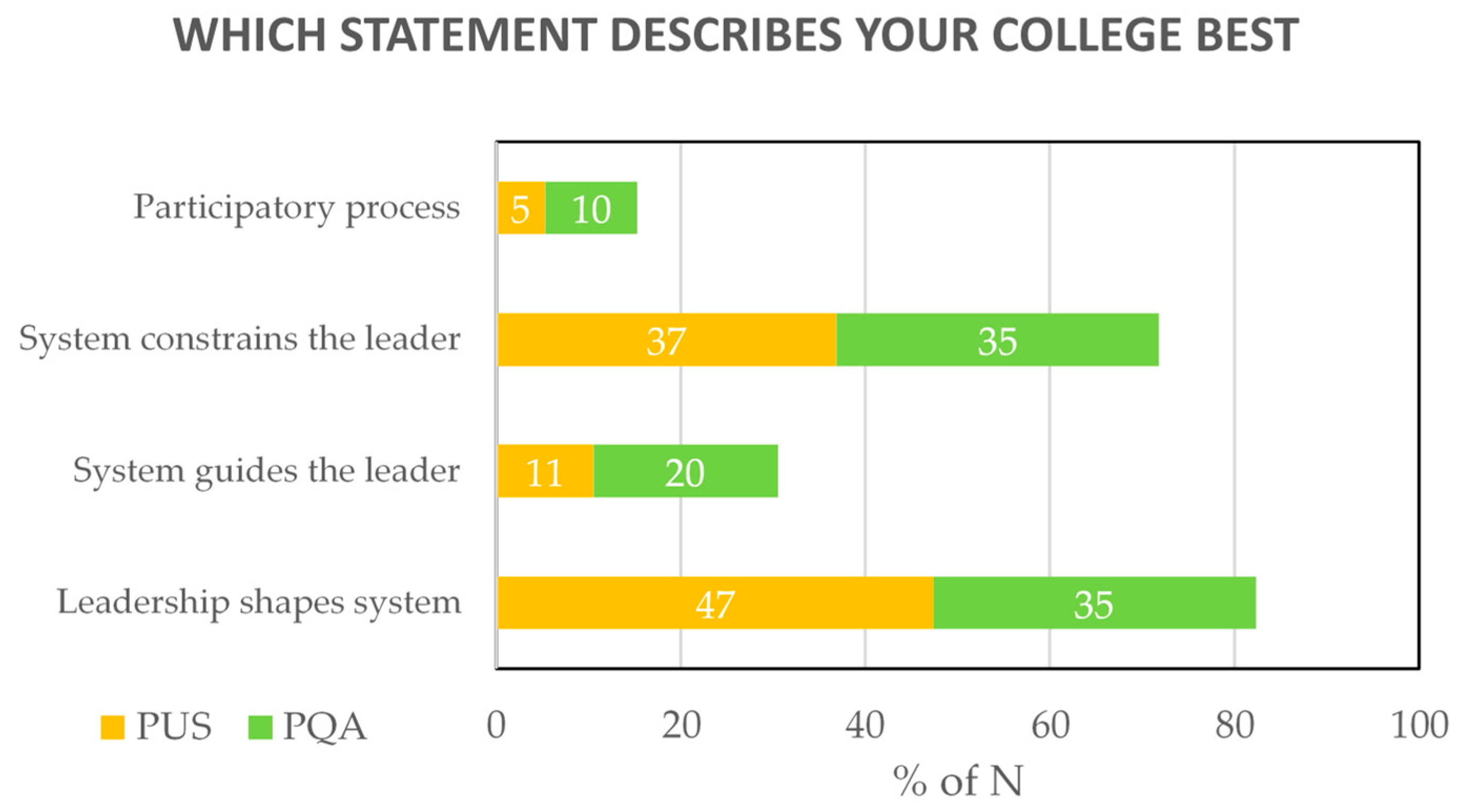
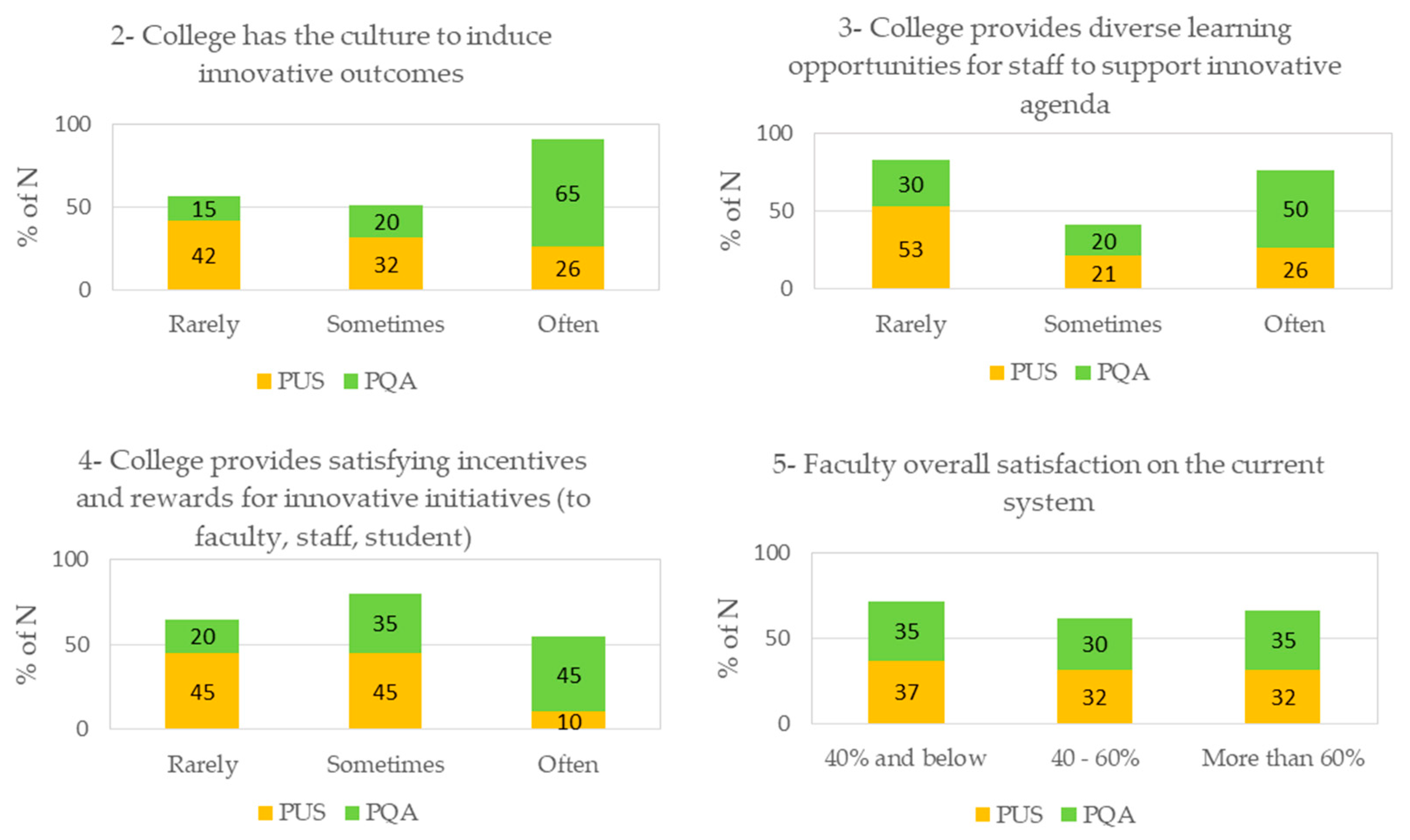
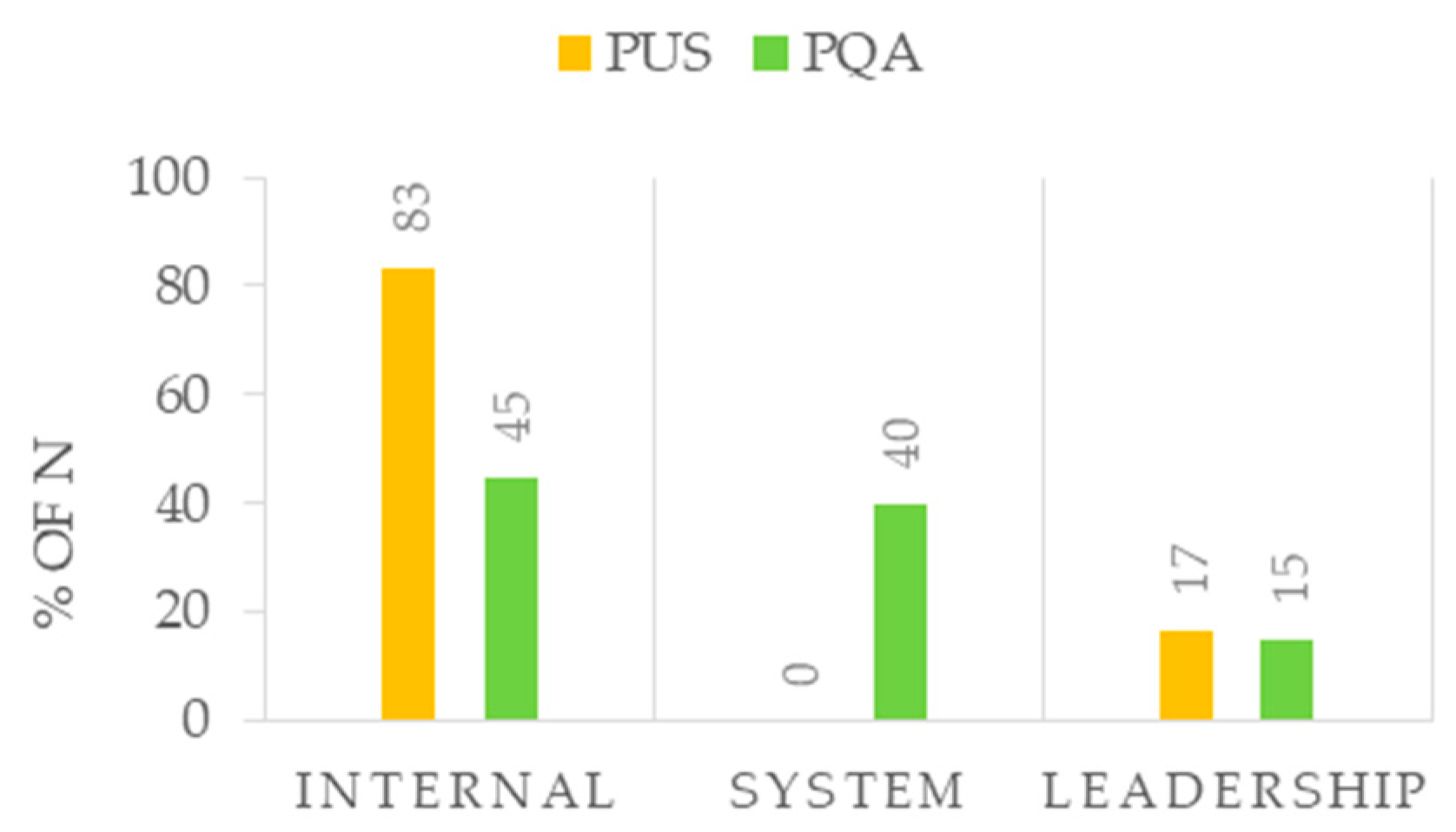
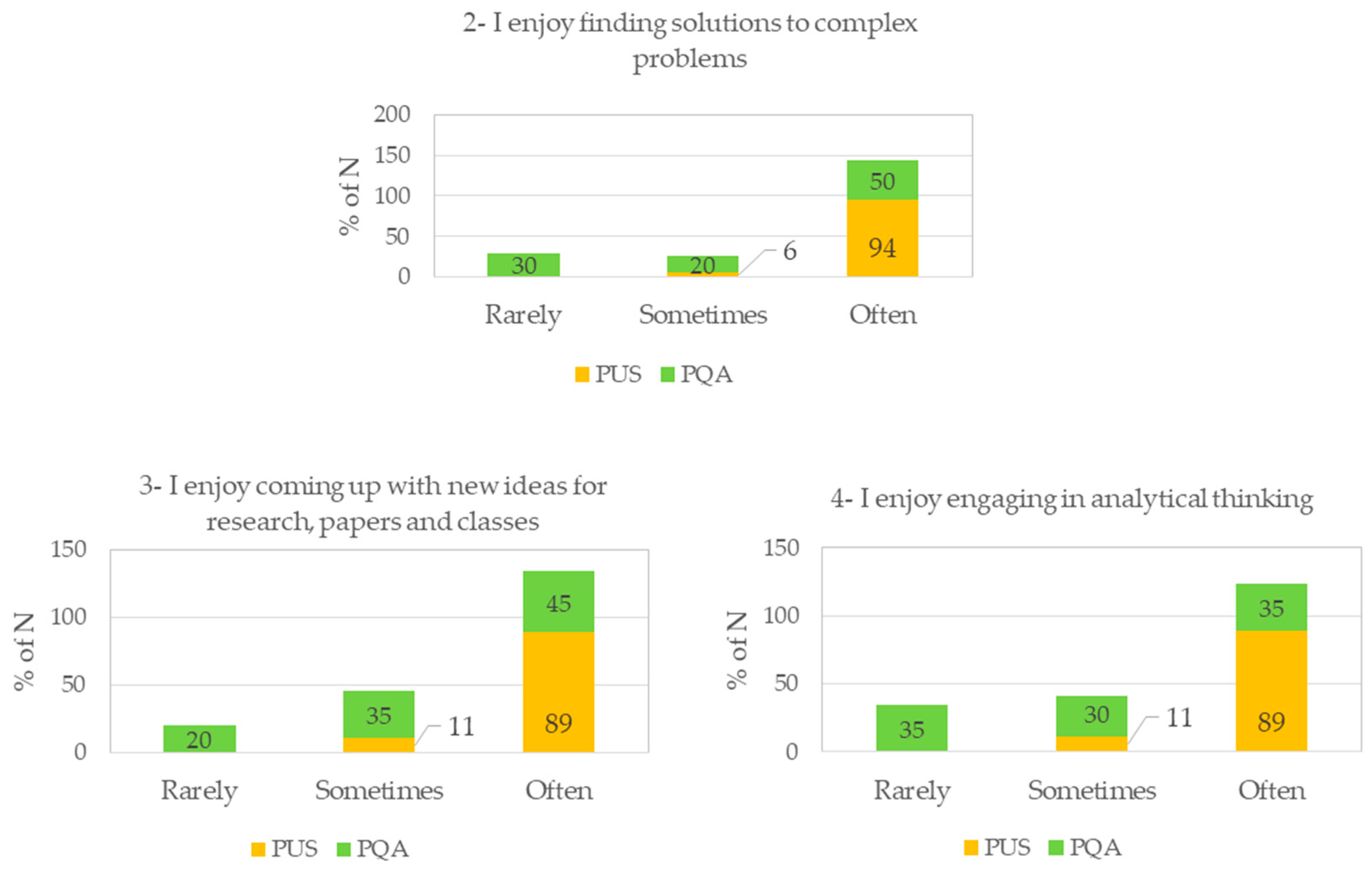
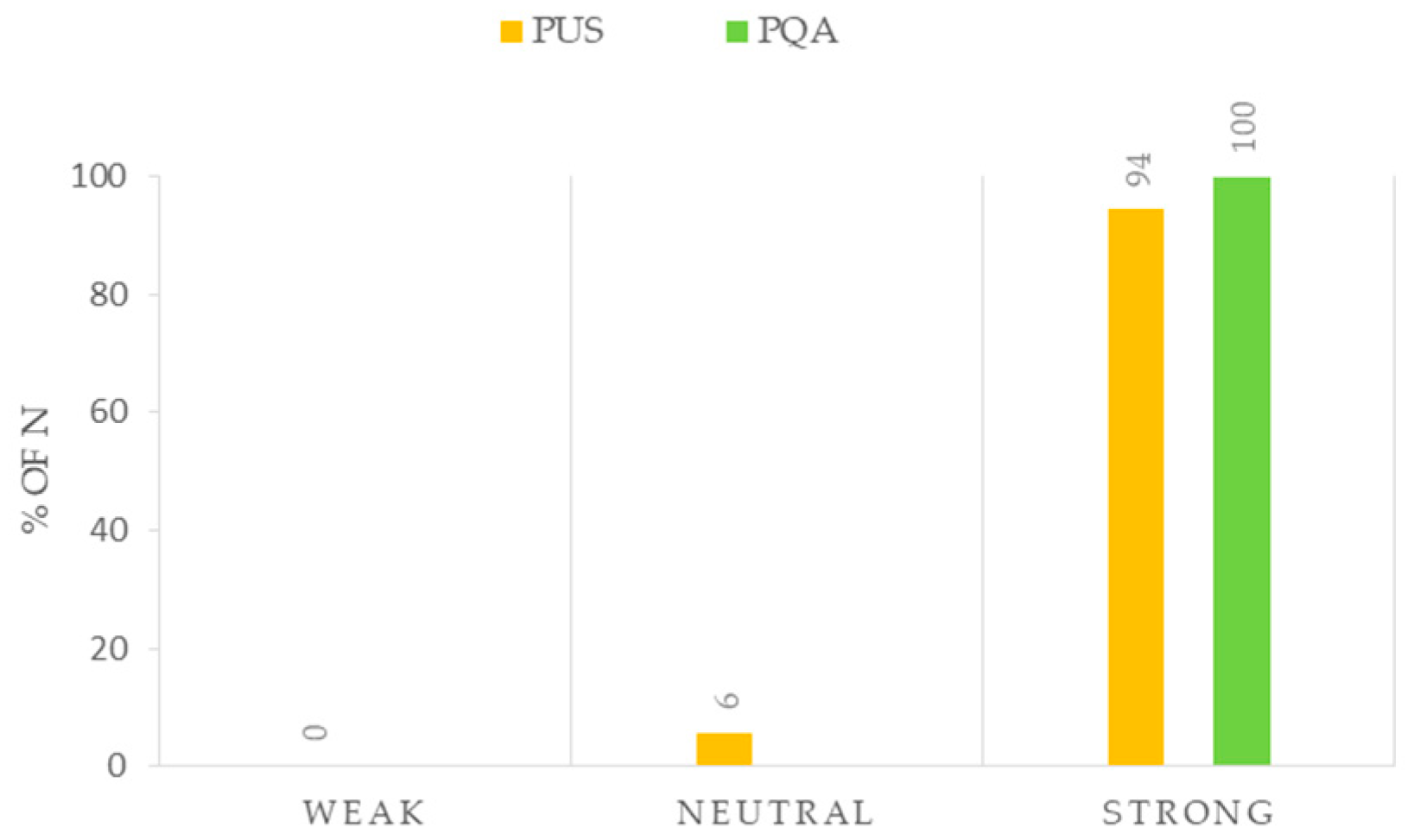


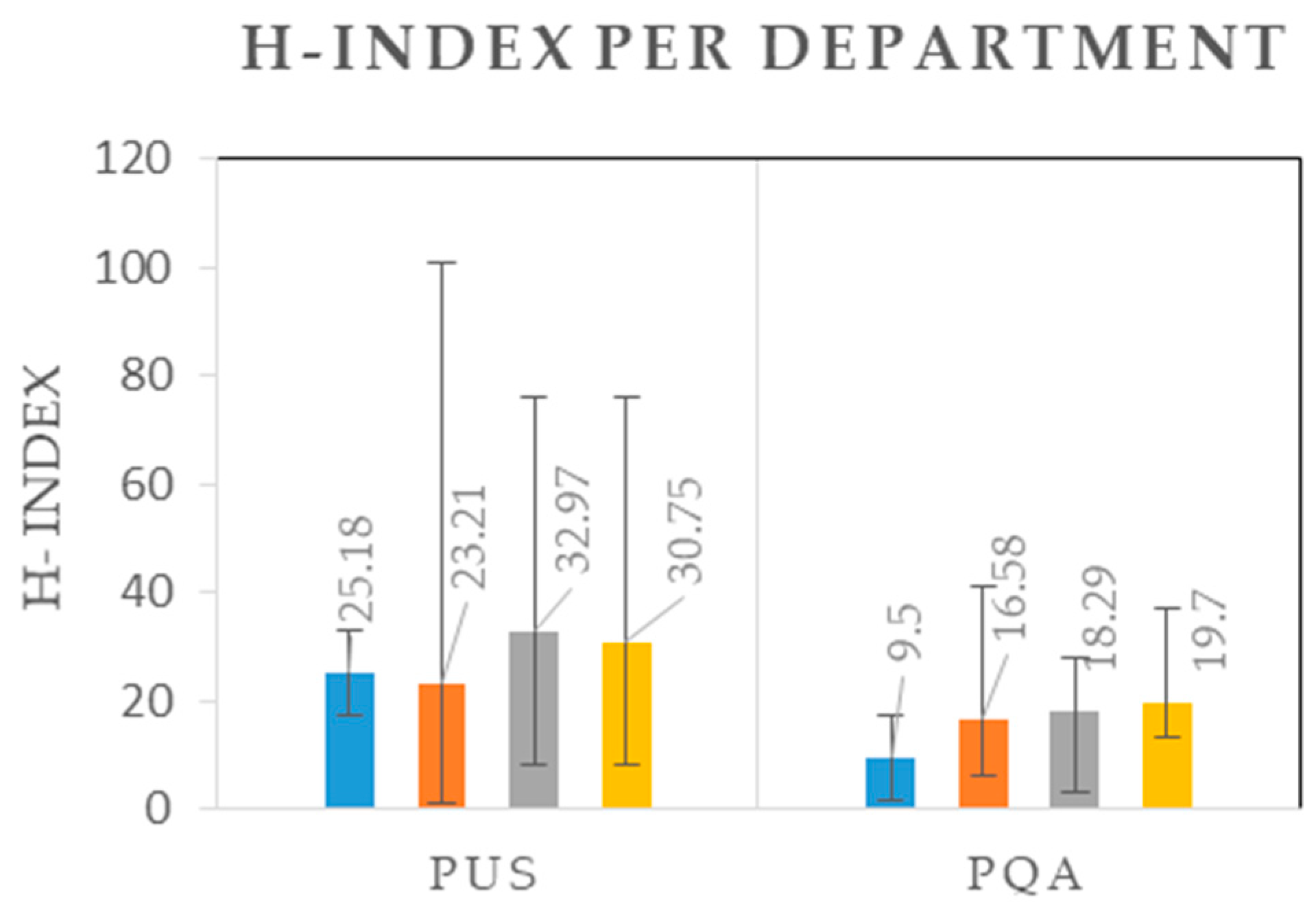
| Margin of Error | Level of Confidence | ||
|---|---|---|---|
| 0.95 | 0.9 | ||
| PUS N = 184 | 3% | 157 | 148 |
| 5% | 124 | 110 | |
| 10% | 63 | 50 | |
| PQA N = 59 | 3% | 56 | 55 |
| 5% | 51 | 48 | |
| 10% | 37 | 32 | |
| N = 39 | M | SD | α |
|---|---|---|---|
| Transformational leadership | |||
| II(A) | 2.282 | 0.837 | 0.893 |
| II(B) | 2.417 | 0.822 | 0.852 |
| IM | 2.801 | 0.733 | 0.767 |
| IS | 1.692 | 1.002 | 0.819 |
| IC | 1.430 | 0.941 | 0.863 |
| Transactional Leadership | |||
| CR | 1.839 | 0.984 | 0.884 |
| MBE(A) | 1.699 | 0.822 | 0.498 |
| Passive Leadership | |||
| MBE(P) | 1.179 | 0.954 | −0.231 |
| LF | 1.109 | 0.699 | −0.552 |
| Leadership outcomes | |||
| EE | 1.726 | 1.299 | 0.866 |
| EF | 2.109 | 1.103 | 0.895 |
| SAT | 1.949 | 1.271 | 0.866 |
| N = 20 PQA Public university in Qatar | N = 19 PUS Public university in US | |||||
|---|---|---|---|---|---|---|
| M | SD | α | M | SD | α | |
| Transformational leadership | ||||||
| II(A) | 2.588 | 0.796 | 0.892 | 1.961 | 0.774 | 0.858 |
| II(B) | 2.600 | 0.923 | 0.899 | 2.224 | 0.671 | 0.786 |
| IM | 2.863 | 0.750 | 0.847 | 2.737 | 0.729 | 0.757 |
| IS | 2.113 | 0.864 | 0.844 | 1.250 | 0.965 | 0.73 |
| IC | 1.925 | 0.799 | 0.853 | 0.908 | 0.796 | 0.858 |
| Transactional Leadership | ||||||
| CR | 2.200 | 0.913 | 0.875 | 1.461 | 0.933 | 0.860 |
| MBE(A) | 1.888 | 1.024 | 0.429 | 1.500 | 0.486 | 0.578 |
| Passive Leadership | ||||||
| MBE(P) | 0.850 | 0.821 | 0.048 | 1.526 | 0.982 | 0.237 |
| LF | 0.850 | 0.656 | −0.400 | 1.382 | 0.653 | 0.556 |
| Leadership outcomes | ||||||
| EE | 2.233 | 1.190 | 0.884 | 1.193 | 1.218 | 0.799 |
| EF | 2.538 | 0.991 | 0.925 | 1.658 | 1.055 | 0.832 |
| SAT | 2.600 | 1.165 | 0.860 | 1.263 | 1.005 | 0.850 |
| (a) | ||||||||||||
| N = 20 | Transformational | Transactional | Passive | Leadership Outcomes | ||||||||
| Percentile | II(A) | II(B) | IM | IS | IC | CR | MBE(A) | MBE(P) | LF | EE | EF | SAT |
| 5 | 0.76 | 0.50 | 1.25 | 0.75 | 0.75 | 0.26 | 0.00 | 0.50 | 0.00 | |||
| 10 | 1.08 | 0.65 | 1.35 | 0.78 | 0.78 | 0.58 | 0.07 | 0.58 | 0.10 | |||
| 20 | 2.05 | 2.25 | 2.50 | 1.10 | 1.05 | 1.30 | 1.07 | 2.00 | 2.00 | |||
| 30 | 2.33 | 2.33 | 2.50 | 1.50 | 1.25 | 1.65 | 2.00 | 2.08 | 2.15 | |||
| 40 | 2.50 | 2.50 | 2.75 | 1.95 | 1.75 | 2.10 | 2.00 | 2.50 | 2.70 | |||
| 50 | 2.50 | 2.63 | 3.00 | 2.25 | 1.88 | 2.38 | 2.33 | 2.63 | 3.00 | |||
| 60 | 2.90 | 2.75 | 3.00 | 2.50 | 2.25 | 2.75 | 2.53 | 2.75 | 3.00 | |||
| 70 | 3.18 | 2.75 | 3.18 | 2.68 | 2.50 | 2.75 | 3.00 | 3.00 | 3.00 | |||
| 80 | 3.25 | 3.45 | 3.65 | 2.75 | 2.70 | 3.00 | 3.00 | 3.45 | 3.50 | |||
| 90 | 3.70 | 3.98 | 3.98 | 3.43 | 2.98 | 3.00 | 4.00 | 3.98 | 4.00 | |||
| (b) | ||||||||||||
| N = 19 | Transformational | Transactional | Passive | Leadership Outcomes | ||||||||
| Percentile | II(A) | II(B) | IM | IS | IC | CR | MBE(A) | MBE(P) | LF | EE | EF | SAT |
| 5 | 0.75 | 1.25 | 1.25 | 0.00 | 0.00 | 0.00 | 0.00 | 0.00 | 0.00 | |||
| 10 | 1.00 | 1.50 | 1.75 | 0.25 | 0.00 | 0.25 | 0.00 | 0.25 | 0.00 | |||
| 20 | 1.25 | 1.75 | 2.25 | 0.25 | 0.00 | 0.50 | 0.00 | 0.75 | 0.00 | |||
| 30 | 1.50 | 1.75 | 2.50 | 0.50 | 0.50 | 1.25 | 0.33 | 0.75 | 0.50 | |||
| 40 | 1.75 | 1.75 | 2.50 | 1.00 | 0.50 | 1.25 | 0.33 | 1.00 | 1.00 | |||
| 50 | 1.75 | 2.00 | 2.50 | 1.00 | 0.75 | 1.25 | 0.67 | 1.75 | 1.50 | |||
| 60 | 2.00 | 2.25 | 2.75 | 1.00 | 0.75 | 1.50 | 1.00 | 2.25 | 1.50 | |||
| 70 | 2.25 | 2.25 | 3.25 | 2.00 | 1.50 | 1.75 | 2.00 | 2.50 | 1.50 | |||
| 80 | 3.00 | 3.00 | 3.50 | 2.25 | 1.50 | 2.50 | 3.00 | 2.50 | 2.50 | |||
| 90 | 3.25 | 3.25 | 4.00 | 2.75 | 2.25 | 3.00 | 3.00 | 3.00 | 3.00 | |||
| 60th Percentile | Transformational | Transactional | Passive | Leadership Outcomes | ||||||||
|---|---|---|---|---|---|---|---|---|---|---|---|---|
| II(A) | II(B) | IM | IS | IC | CR | MBE(A) | MBE(P) | LF | EE | EF | SAT | |
| Norm N = 12,118 | 3.25 | 3.00 | 3.25 | 3.00 | 3.17 | 3.13 | 3.00 | 3.25 | 3.50 | |||
| PQA N = 20 | 2.90 | 2.75 | 3.00 | 2.50 | 2.25 | 2.75 | 2.53 | 2.75 | 3.00 | |||
| PUS N = 19 | 2.00 | 2.25 | 2.75 | 1.00 | 0.75 | 1.50 | 1.00 | 2.25 | 1.50 | |||
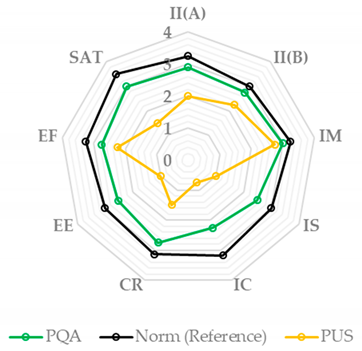 | ||
|---|---|---|
| Trait/Outcome | PQA Distance from Norm | PUS Distance from Norm |
| II(A) | −0.35 | −1.25 |
| II(B) | −0.25 | −0.75 |
| IM | −0.25 | −0.5 |
| IS | −0.5 | −2 |
| IC | −0.92 | −2.42 |
| CR | −0.38 | −1.63 |
| EE | −0.47 | −2 |
| EF | −0.5 | −1 |
| SAT | −0.5 | −2 |
| PQA | PUS | ||||||
|---|---|---|---|---|---|---|---|
| EE | EF | SAT | EE | EF | SAT | ||
| Transformational | II(A) | 0.774 ** | 0.938 ** | 0.870 ** | 0.622 ** | 0.782 ** | 0.773 ** |
| II(B) | 0.860 ** | 0.888 ** | 0.847 ** | 0.606 ** | 0.805 ** | 0.742 ** | |
| IM | 0.760 ** | 0.901 ** | 0.897 ** | 0.707 ** | 0.771 ** | 0.669 ** | |
| IS | 0.754 ** | 0.752 ** | 0.707 ** | 0.693 ** | 0.682 ** | 0.637 ** | |
| IC | 0.766 ** | 0.801 ** | 0.729 ** | 0.802 ** | 0.800 ** | 0.848 ** | |
| Transactional | CR | 0.863 ** | 0.875 ** | 0.859 ** | 0.785 ** | 0.801 ** | 0.804 ** |
| PQA | PUS | ||||||||
|---|---|---|---|---|---|---|---|---|---|
| Culture | Diverse Learning | Incentives And Rewards | System Satisfaction | Culture | Diverse Learning | Incentives And Rewards | System Satisfaction | ||
| Transform-ational | II(A) | 0.796 ** | 0.558 * | 0.717 ** | 0.234 | 0.801 ** | 0.504 * | 0.692 ** | 0.665 ** |
| II(B) | 0.822 ** | 0.738 ** | 0.684 ** | 0.187 | 0.784 ** | 0.553 * | 0.624 ** | 0.618 ** | |
| IM | 0.792 ** | 0.600 ** | 0.698 ** | 0.250 | 0.527 * | 0.416 | 0.534 * | 0.517 * | |
| IS | 0.645 ** | 0.590 ** | 0.569 ** | 0.040 | 0.778 ** | 0.602 ** | 0.642 ** | 0.612 ** | |
| IC | 0.527 * | 0.438 | 0.493 * | 0.204 | 0.672 ** | 0.585 ** | 0.762 ** | 0.805 ** | |
| Transactional | CR | 0.749 ** | 0.729 ** | 0.703 ** | 0.241 | 0.769 ** | 0.604 ** | 0.814 ** | 0.835 ** |
| PQA | PUS | ||||||||||
|---|---|---|---|---|---|---|---|---|---|---|---|
| Innovation Driver | Solving Complex Problems | Producing New Ideas | Analytical Thinking | Internal Motivation level | Innovation Driver | Solving Complex Problems | Producing New Ideas | Analytical Thinking | Internal Motivation level | ||
| Transformational | II(A) | −0.088 | 0.333 | 0.131 | 0.060 | 0.348 | −0.258 | 0.217 | 0.310 | 0.367 | 0.126 |
| II(B) | 0.027 | 0.304 | 0.091 | 0.207 | 0.079 | −0.299 | 0.172 | 0.290 | 0.235 | 0.062 | |
| IM | −0.103 | 0.437 | 0.195 | 0.144 | 0.198 | −0.182 | 0.312 | 0.320 | 0.324 | −0.214 | |
| IS | −0.193 | 0.176 | −0.044 | 0.162 | 0.107 | −0.373 | 0.180 | 0.191 | 0.173 | 0.077 | |
| IC | −0.265 | 0.106 | −0.010 | 0.160 | 0.273 | −0.357 | −0.148 | −0.078 | 0.065 | −0.238 | |
| Transactional | CR | 0.075 | −0.014 | −0.165 | −0.007 | −0.025 | −0.427 | 0.053 | 0.150 | 0.217 | −0.068 |
| PQA | PUS | |
|---|---|---|
| Leadership outcomes: | ||
| EE | CR | IC |
| EF | II(A) | II(B) |
| SAT | IM | IC |
| System: | ||
| Innovative Culture | II(B) | II(A) |
| Diverse learning opportunities | II(B) | CR |
| Incentives and rewards | II(A) | CR |
| Overall system satisfaction | none | CR |
| Professor | Associate Professor | Assistant Professor | |
|---|---|---|---|
| PUS | 107 | 48 | 36 |
| % of N | 56.02 | 25.13 | 18.85 |
| PQA | 25 | 25 | 11 |
| % of N | 40.98 | 40.98 | 18.04 |
© 2019 by the authors. Licensee MDPI, Basel, Switzerland. This article is an open access article distributed under the terms and conditions of the Creative Commons Attribution (CC BY) license (http://creativecommons.org/licenses/by/4.0/).
Share and Cite
Al-Mansoori, R.S.; Koç, M. Toward Knowledge-Based Economy: Innovation and Transformational Leadership in Public Universities in Texas and Qatar. Sustainability 2019, 11, 6721. https://doi.org/10.3390/su11236721
Al-Mansoori RS, Koç M. Toward Knowledge-Based Economy: Innovation and Transformational Leadership in Public Universities in Texas and Qatar. Sustainability. 2019; 11(23):6721. https://doi.org/10.3390/su11236721
Chicago/Turabian StyleAl-Mansoori, Reem S., and Muammer Koç. 2019. "Toward Knowledge-Based Economy: Innovation and Transformational Leadership in Public Universities in Texas and Qatar" Sustainability 11, no. 23: 6721. https://doi.org/10.3390/su11236721
APA StyleAl-Mansoori, R. S., & Koç, M. (2019). Toward Knowledge-Based Economy: Innovation and Transformational Leadership in Public Universities in Texas and Qatar. Sustainability, 11(23), 6721. https://doi.org/10.3390/su11236721





